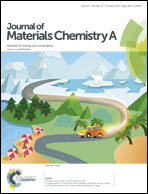CdSe quantum dots/molecular cobalt catalyst co-grafted open porous NiO film as a photocathode for visible light driven H2 evolution from neutral water†
Abstract
An active noble-metal-free photocathode was fabricated by co-grafting water-soluble thioglycolic acid-stabilized CdSe quantum dots and a molecular cobaloxime catalyst (CoP) through chemical linkage on a p-type open porous NiO film. This photocathode was used as a working electrode in a three-electrode cell, which displayed a photocurrent density up to 110 µA cm−2 at an applied potential of 0 V vs. NHE in 0.1 M Na2SO4 solution at pH 6.8 upon visible light illumination. The comparative studies showed that the open porous NiO/CdSe electrode did display a higher photocurrent density than that exhibited by an analogous planar NiO/CdSe electrode made by doctor-blading a NiO paste. Long-time photoelectrolysis experiments revealed that about 83% of the photocurrent density remained after 3.5 h illumination at −0.2 V vs. NHE. The open porous NiO/CdSe/CoP photocathode showed a considerably better current density and photocatalytic stability compared to the so-far reported dye- or QD-sensitized NiO cathodes with a cobaloxime catalyst chemically attached or physically adsorbed on the electrode surface under similar conditions.


 Please wait while we load your content...
Please wait while we load your content...